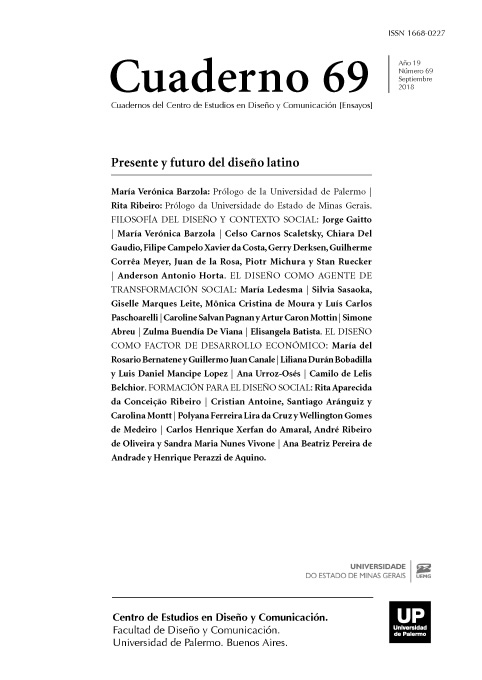Diseño y desarrollo: la innovación responsable mediante el Design Thinking
Résumé
El presente texto intenta ser un ejercicio de introducción al Design Thinking como método de trabajo en diseño aplicable a otros ámbitos empresariales. Pero también como forma de entender la profesión y en parte, incluso, como una actitud vital que contempla como centro de atención la responsabilidad social (tanto del otro-usuario como del entorno sostenible). A partir de la definición de esta metodología y de la aproximación a sus orígenes, se plantea la relación entre la aparición del Design Thinking, y los valores éticos y sociales de la teoría del diseño que surge en los años 60 y 70.
Références
Barnbrook, J.; Bwell, N.; VanderLans, R.; Wilkinson, B. (1998). “First Things First 2000: A Design Manifesto” en Adbusters (número 27, pp. 56-57). Disponible en: http://www.manifesto project.it/adbusters/
Benjamin, W. (1934). El autor como productor. México: Itaca.
Bjerknes, G., Bratteteig, T. (1995). User Participation and Democracy: A Discussion of Scandinavian Research on System Development, en Scandinavian Journal of Information Systems (volumen 7, número 1, pp. 73-98). Disponible en: http://home.ifi.uio.no/tone/Publications/Bjerk-bratt-sjis-i95.html
Brown, B.T. (2009) Change by Design. How Design Thinking transforms Organizations and inspires Innovation. New York: HarperCollins.
Curedale, R. (2013). Design thinking: Process and methods manual. Topanga, CA: Design Community College.
Curedale, R. (2013). 50 selected design methods to transform your design. Topanga, CA: Design Community College.
Dunne, A. y Raby, F. (2013). Speculative Everything: Design, Fiction, and Social Dreaming. 1a ed. Cambridge, MA/London: MIT Press.
Faste, R. (1994). “Ambidextrous Thinking” en Innovations in Mechanical Engineering Curricula for the 1990s. New York: American Society of Mechanical Engineers.
Fry, T. (2011). Design as politics. New York: Berg.
Garland, K.; Whright, E.; Carpenter, R.; Briggs, K. (1964). First things first. London: Goodwin Press. Disponible en: http://www.designishistory.com/1960/first-things-first/
Hennessey, J.; Papanek, V. (2008). Nomadic furniture: D-I-Y projects that are lightweight and light on the environment. Atglen, Penn: Schiffer Pub.
Howard, A. (1994). “There is such thing as society”, en Eye Magazine (volúmen 13).
Lupton, E. (1998). “The Designer as Producer”, en Heller, S. (ed.) (2005). The Education of a Graphic Designer. New York: Allworth Press.
Papanek, V. (1985). Design for the Real World. Human Ecology and Social Change. (2ª ed) London: Thames and Hudson.
Patnaik, D. (2009). Forget Design Thinking and Try Hybrid Thinking. Disponible en: http://www.fastcompany.com/1338960/forget-design-thinking-and-try-hybrid-thinking
Pelta, R. (2012). Diseñar para el cambio social. Monográfica.org [Revista en línea]. Disponible en: 2015, SeptiembrePapanek, V. J. 2015, Septiembre
Papanek, V. J. http://www.monografica.org/02/Opini%C3%B3n/3112
Rispoli, E. (2015). El diseñador como productor. Reflexiones en torno a la idea de responsabilidad social en el diseño contemporáneo. Obra Digital [Revista en línea]. Disponible en: http://revistesdigitals.uvic.cat/index.php/obradigital/article/view/65/77
Tschimmel, K. (2012). Design Thinking as an effective Toolkit for Innovation. En Proceedings of the XXIII ISPIM Conference: Action for Innovation: Innovating from Experience. Barcelona.
Los autores/as que publiquen en esta revista ceden los derechos de autor y de publicación a "Cuadernos del Centro de Estudios de Diseño y Comunicación", Aceptando el registro de su trabajo bajo una licencia de atribución de Creative Commons, que permite a terceros utilizar lo publicado siempre que de el crédito pertinente a los autores y a esta revista.


